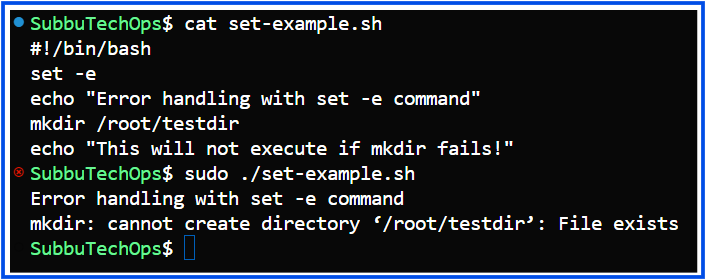Error handling is crucial in shell scripting to ensure smooth execution and better debugging.
👉 https://youtu.be/YGX9pTRSUls?si=wPFoAUsfai8q-0WS
Below are various ways to handle errors effectively:
1. Exit Status ($?):
=> Every command in Linux returns an exit status (0 for success, non-zero for failure).
=> You can check the exit status using $?.
Example:
#!/bin/bash
mkdir /root/testdir # Trying to create a directory in a restricted location
echo "Exit Status: $?" # Check the exit status (0 = success, non-zero = failure)
💡 Best Practice: Use exit status checks to handle errors.
Before handling the error:


Explanation
- mkdir returns an error because /root/testdir already exists.
- The exit status ($?) of mkdir is
1, indicating failure. - The script correctly prints Exit Status: 1, confirming that mkd
irfailed.
After handling the error:
#!/bin/bash
mkdir /root/testdir
if [[ $? -ne 0 ]]; then
echo "Error: Failed to create directory!"
exit 1 # Exit script with error
fi

2. Using set -e (Exit on Error):
set -e makes the script exit immediately if any command fails.
#!/bin/bash
set -e # Exit on error
echo "Error handling with set -e command"
mkdir /root/testdir # This will cause the script to exit if it fails
echo "This will not execute if mkdir fails!"
⚠️ Be cautious: This might terminate the script abruptly if you don’t handle errors properly.


3.1. Using trap for Error Handling:
trap allows custom error handling before the script exits.
✅ trap helps in error handling and cleanup.
✅ trap ‘command’ ERR runs when a command fails.
✅ Always test trap carefully to avoid unexpected behaviors.
#!/bin/bash
trap 'echo "An error occurred! Exiting..."; exit 1' ERR
mkdir /root/testdir # If this fails, the trap executes
echo "This will not run if an error occurs!"


3.2. Custom cleanup using trap:
✅ Use trap ‘command’ ERR to run cleanup on script exit
✅ Use trap ‘command’ EXIT to run cleanup on script exit (even if successful).
Example 1: A script which exits when a command fails
#!/bin/bash
trap 'echo "Cleaning up..."; rm -rf /tmp/tempfile; exit 1' ERR
touch /tmp/tempfile # Temporary file
mkdir /root/testdir # Fails, triggering the trap

1. The trap command sets up a handler for errors (ERR).
2. If any command fails, the script:
- Prints “Cleaning up…”.
- Prints “Cleaning up…”.
- Removes the temporary file (/tmp/tempfile).
What Happens If /root/testdir Does Not Exist?
- mkdir /root/testdir succeeds.
- Since there is no error, the trap is not triggered.
- The script exits normally.
Example 2: A script which exits normally
#!/bin/bash
trap 'echo "Cleaning up..."; rm -rf /tmp/tempfile; exit 1' ERR
touch /tmp/tempfile # Temporary file
echo "Hello World!"

✅ Ensure Cleanup Even on Manual Script Exit:
#!/bin/bash
trap 'echo "Cleaning up..."; rm -rf /tmp/tempfile' ERR EXIT
touch /tmp/tempfile
echo "Hello World!"
- Now, cleanup happens even if the script exits normally (EXIT).
- Prevents leftover temp files.

4. Using || (OR) for Error Handling
The || operator allows fallback commands if the first one fails.
#!/bin/bash
mkdir /root/testdir || echo "Error: Cannot create directory!"

5. Using && (AND) to Ensure Success Before Execution
The && operator only runs the second command if the first succeeds.
✅ When /tmp/mydir does not exist (Success case):
#!/bin/bash
mkdir /tmp/mydir && echo "Directory created successfully!"

❌ When /tmp/mydir already exists (Failure case):
#!/bin/bash
mkdir /tmp/mydir && echo "Directory created successfully!" || echo "Error: Failed to create directory!"

📌 Explanation:
- If mkdir succeeds → “Directory created successfully!” prints.
- If mkdir fails → “Error: Failed to create directory!” prints.
6. Using if Condition for Error Handling
Using if to check command success/failure.
#!/bin/bash
if mkdir /root/testdir; then
echo "Directory created successfully!"
else
echo "Error: Cannot create directory!"
exit 1
fi

7. Redirecting Error Messages
Redirect errors to a file for logging.
#!/bin/bash
mkdir /root/testdir 2>> error.log
echo "Check error.log for details!"

- If the directory is created successfully, nothing happens (no error is logged).
- If the directory already exists or the user does not have permission, an error message is logged.
- 2>> redirects only errors (stderr) to the error.log file.
- If mkdir fails, the error message is appended (>>) to error.log.
8. Handling Errors in Loops
Break or continue on errors in loops.
#!/bin/bash
for dir in /root/testdir /tmp/testdir; do
mkdir "$dir" || { echo "Failed to create $dir, skipping..."; continue; }
echo "$dir created!"
done

🔍 How to Break the Loop When mkdir Fails:
#!/bin/bash
for dir in /root/testdir /tmp/testdir; do
mkdir "$dir" || { echo "Failed to create $dir, skipping..."; break; }
echo "$dir created!"
done

9. Debugging with set -x
set -x prints each command before execution for debugging.
#!/bin/bash
set -x # Enable debugging
mkdir /root/testdir
echo "Debugging enabled!"

Disable debugging with set +x:
set +x # Disable debugging

10. Using exit to Terminate on Errors
Use exit with an error code (non-zero) to terminate script execution.
#!/bin/bash
mkdir /root/testdir || { echo "Error: Cannot create directory!"; exit 1; }

✔ If mkdir succeeds, nothing happens (unless you add a success message).
✔ If mkdir fails, it prints "Error: Cannot create directory!” and exits.
✔ Use && echo “Success!” for better visibility.
📌 Best Practices for Shell Script Error Handling:
✅ Always check exit codes ($?)
✅ Use set -e for critical scripts
✅ Use trap to handle unexpected failures
✅ Log errors using 2>> logfile.log
✅ Use || to execute fallback commands
✅ Use set -x for debugging complex scripts
Your Thoughts Matter!
I’d love to hear what you think about this article — feel free to share your opinions in the comments below (or above, depending on your device!). If you found this helpful or enjoyable, a clap, a comment, or even a highlight of your favorite sections would mean a lot.
For more insights into the world of technology and data, visit subbutechops.com. There’s plenty of exciting content waiting for you to explore!
🔔 Subscribe for more DevOps, Shell Scripting, and Kubernetes tutorials:
👉 https://www.youtube.com/@SubbuTechTutorialsThank you for reading, and happy learning! 🚀


